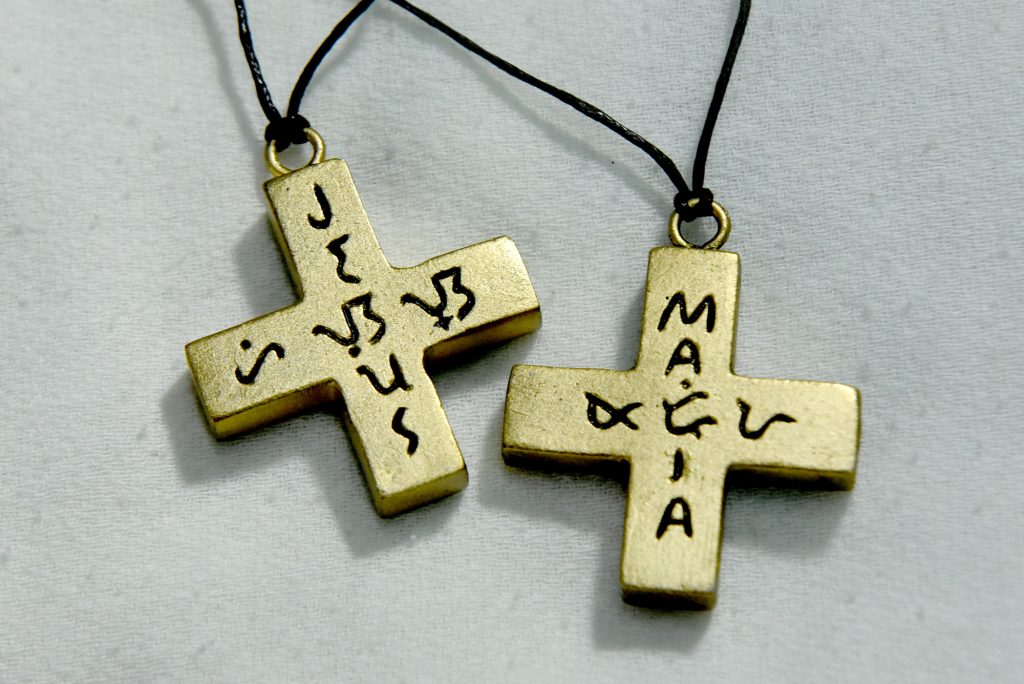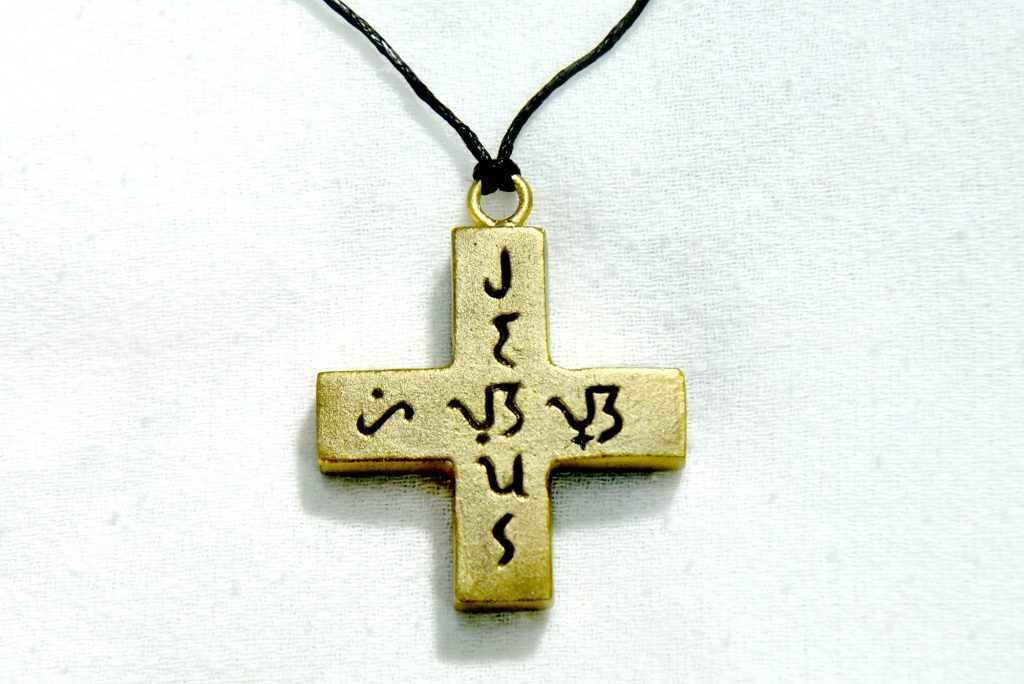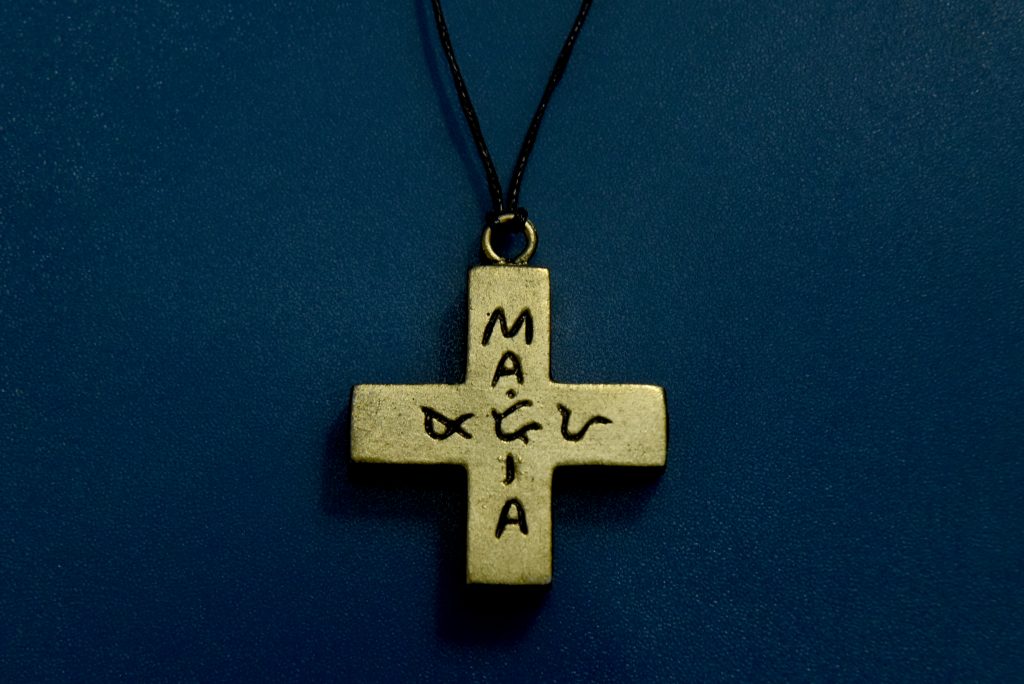
What’s wrong with the “Mission Cross” that many Filipino Catholics now wear, some as a fashion accessory, to mark the quincentennial of the arrival of Christianity in the country?
Some say the words “Jesus” and “Mary” written in ancient Baybayin, a pre-colonial script, on the pendants are misspelled.
Others, however, say the script is actually a mix of Roman characters and ancient Baybayin symbolizing “the encounter of the faith from Western missionaries and our own culture and life.”
“Baybayin is a language, and there are rules to a language, and strictly speaking, [the script on the cross] is wrong,” said Dustin Ancheta, a historian and cultural intelligence expert.
“Romanizing it is a rule you try to avoid,” he told LiCAS.news, adding that there are two “perspectives” — traditionalist and modernist — in reading Baybayin.
A traditionalist believes that Baybayin should remain “fixed” and should only use the ancient syllabary used before the arrival of the Spaniards.
A modernist, on the other hand, believes that like all languages, the Baybayin should evolve.
Writing Joseph and Mary wrong
On the “Mission Cross” now circulating, the word “Maria” written horizontally is “wrong” because it is “transliterated,” said Ancheta.
“The first rule of Baybayin is to syllabicate and spell the word according to how you hear it,” he said, adding that the “Maria” on the cross should be read as “Ma-ri-ya.”
He said, however, that neither the “traditionalists” nor the “modernists’ would end the word with an “a.”
The vertical design is also misspelled as “Mariiya.”
The historian, however, said “there’s a claim toward artistic license” by mixing the Baybayin syllabary and the Roman characters.
The same goes with the word “Jesus” in the cross that actually reads as “Hesuus,” but is saved by “artistic license.”
The horizontal “Hesus,” Tagalog for Jesus, with the virama in the end is, for the “modernist,” correct.

Ancheta, however, said using the “Baybayin” on the “Mission Cross” is “ironic.”
The book “Doctrina Christiana,” or “Christian Doctrine,” uses a mix of Baybayin and Roman script to help early Filipinos read and understand the prayers.
Kristian Kabuay, an artist-entrepreneur who specializes in endangered writing systems, said that more than the text, the usage of the pre-colonial script to attract attention is “recolonization.”
“The ‘Mission Cross’ is an extension of the Doctrina Christiana, which was done not to preserve the writing, but to indoctrinate,” he said.
“It’s a bit odd, yet a fitting way to reintroduce Christianity,” said Kabuay, noting the use of a pre-colonial Christian writing system “to attract people to Christianity.”
Kabuay said “ethical questions” should be raised in the use of designs that are “inappropriate,” especially with respect to pre-colonial culture.
“What about the pre-colonial religion? Do they care about that? Or did they only appropriate the pre-colonial system because it looks cool?” he said.
“What about the Babaylans, the Philippine shamans, do they have any respect for them?” added Kabuay.

Catholic Church leaders said they were aware of the criticisms about the use the the script on the “Mission Cross.”
“We consulted many Baybayin enthusiasts and many of them agreed on the design, but of course we can’t avoid people with preference,” said Father Kali Llamado, vice rector of the Manila Cathedral and head of the quincentennial celebrations in the Archdiocese of Manila.
He said the idea is to bring back the old Filipino Catholic tradition of wearing a cross “so Catholics will be reminded of our identity.”
“With the design, well, for the younger generation, there is a craze for the ‘Baybayin,’” he said.
“We would want to reach … especially to those who have gone far from the Church,” said the priest.
He said name “Jesus” is inscribed on the front of the cross because he is “the center of the mission.”
The priest said a vertical design with “Jesus” spelled using Roman script and Baybayin is “a symbol of the meeting of the Western missionaries bringing the faith to us.”
He said the design also shows the “intersection” of the Western faith with the Filipino pre-colonial culture.
“It is very important especially in our world today, even in Catholic theology,” he said. “That is what we understand as enculturation,” said Father Kali, adding that many elements of how Filipinos live out their Catholic faith is influenced by culture.
The name of Mary on the other side of the cross shows the Filipino devotion to the mother of Jesus.
On the use of Baybayin, the priest admitted “colonial reasons,” but he said that “Filipino culture and our faith had a beautiful interaction and resulted into a very vibrant Filipino Catholic faith.”
“Even the bishops said that we do not ignore the fact that there were colonial reasons why we are here, but at the end, Filipinos rejected colonialism but retained Christianity,” he said.
Ancheta, however, said that for “traditionalists” the Baybayin is the “purest form or proof of pre-colonial culture” and “if you touch it, you are desecrating it.”
The problem is Baybayin is “a dead language with different sectors trying to resurrect it,” said Ancheta, adding that the use of the script these days, whether wrong or right, is “necessary for now.”
Source: Licas Philippines
0 Comments